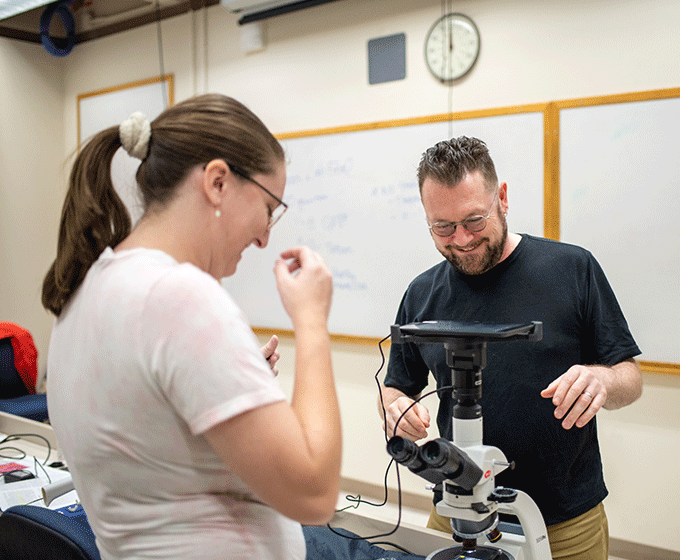
Alan Whittington (right) co-leads research exploring planetary surfaces for the UTSA Center for Advanced Measurements in Extreme Environments (CAMEE). A $2 million renewal grant from NASA will bolster CAMEE’s research and experiential learning opportunities.
SEPTEMBER 7, 2022 — Portions of artificial Mars landscape rest along the walls of the UTSA Center for Advanced Measurements in Extreme Environments (CAMEE), where Kiran Bhaganagar, the center’s director, spoke about plans to use a recent $2 million grant renewal from NASA to fortify a culture of student success.
The terrains of outer space and earth are two focal points for the center, where students conduct research on extreme conditions such as oceans and polar warming, sweeping wildland fires, volcanos and planetary atmospheres. The UTSA students also study the challenging conditions produced when traveling at hypersonic speeds.
In addition to supporting graduate and undergraduate researchers, the newly awarded funds will allow for laboratory renovations that will expand the center’s research on extreme landscapes. The center already has a test-site for a student-developed 3D-printed Mars Rover. In the new lab, students will be able to incorporate virtual reality modules and additional 3D-printed robotics to their projects.

This photo of an iceberg was taken during UTSA professor and sea ice geophysicist Stephen Ackley’s first trip to Antarctica in 2006. Polar warming is one of several focal points for CAMEE’s undergraduate and graduate research. Photo by Ute Kaden
Working with big data, high-speed experimental wind tunnels, in-situ ocean and volcanic measurements and turbulence high-fidelity models, students will have the chance to further explore the extraterrestrial environments of the Moon and Mars along with Earth’s extreme climate.
UTSA received an initial $3 million from NASA in 2019 to develop CAMEE. The center promotes interdisciplinary collaboration across multiple colleges, training a diverse group of students from undergraduate to doctoral levels in multidisciplinary research and data-fusion technologies.
CAMEE has become crucial to projects on this planet. For example, increasing occurrences of wildfires have prompted students at UTSA to study preventive methods. Through their research, they are filling the gap in the fundamental science of predicting and controlling wildland fires, Bhaganagar said.
This fire research includes mapping the climate with drones to predict the direction of a fire. Students are also using drones, land rovers and sensors to study the air, land and water. The goal is to provide proactive research to battle wildfires, Bhaganagar explained, adding that her hope is to apply real-time data research in the form of sensors for fire department personnel.
“The students’ experience is just as important as the research they are conducting,” Bhaganagar said. “We are fostering a collaborative space where students receive hands-on involvement in their work.”
By 2028, UTSA hopes to provide 75% of its undergraduate students with hands-on learning experiences before they graduate.
Since assuming the helm of CAMEE, Bhaganagar has worked to establish the center as a hub of inspiration to ignite curiosity in students at a young age through peer mentorship programs. UTSA’s CAMEE hosts events with the goal to increase the involvement of women in STEM through tours of various labs with female researchers on hand to showcase their work. Undergraduate, graduate and doctoral students also participate in educational outreach programs with visits to elementary classrooms.
One of NASA’s top priorities is developing its next-generation workforce by encouraging females and underserved student populations to become interested in science, technology, engineering and math curriculum from, starting at the K-12 levels and advancing into college and beyond. UTSA’s commitment to advance social mobility and economic opportunities for its students and their communities were important factors in NASA funding CAMEE.
Four CAMEE students, including an undergraduate student, interned at NASA this year. Several doctoral students have also been recognized with awards, like Mansi Joshi, who was awarded the Future Investigators in NASA Earth and Space Science and Technology Fellowship.
“We want to establish a culture for the students while nurturing a pipeline through basic exposure, a deeper understanding and love for learning,” Bhaganagar said. “Their enthusiasm along with the support from UTSA leadership and the dedication of CAMEE thrust leaders in hands-on training has contributed to these successes. Our vision is to continue expanding the reach of CAMEE to more students both at UTSA and in south Texas.”
UTSA Today is produced by University Communications and Marketing, the official news source of The University of Texas at San Antonio. Send your feedback to news@utsa.edu. Keep up-to-date on UTSA news by visiting UTSA Today. Connect with UTSA online at Facebook, Twitter, Youtube and Instagram.
The College of Sciences welcomes our newest Roadrunners to UTSA at VIVA Science! This interactive event connects students with faculty, staff, student leaders, and peers while highlighting the opportunities available across the College. Enjoy mock lectures, wayfinding, and other activities to help you feel connected and ready for academic success.
Outdoor Learning Environment 2 (OLE), Flawn Building, Main CampusWe're excited to welcome the new class of UTSA College of Liberal and Fine Arts (COLFA) students to campus! Move In To COLFA is strongly recommended for new students in COLFA because it gives you the chance to learn about the Student Success Center, learn how to do college successfully and meet new friends.
Galleria (MH 2.01), McKinney Humanities Building, Main CampusBuild connections with your Alvarez College of Business peers and learn more about the Career Compass program! This opportunity will provide fun interactions, giveaways and a chance to meet your next friend!
Richard Liu Auditorium (BB 2.01.02,) Business Building, Main CampusCelebrate the end of summer and the start off a great fall semester with The Housing Block Party! This event will have live music, carnival-style treats, artists, games, and activities galore. Come and join us for a night of fun!
Multipurpose Room/Lawn, Guadalupe Hall, Main CampusBe part of an unforgettable night as SOSA takes the field for its first public performance of the season! Experience the power, pride, and pageantry of UTSA’s marching band. Learn beloved traditions, practice cheers, and feel what it means to be a Roadrunner.
Campus Rec FieldsAfter getting your student settled in their room, connect with other UTSA families at our Family Get Together. Attendees need to RSVP for the event.
Rock & Brews Restaurant - 5702 Landmark Pkwy, San Antonio, TX 78249Late Night at the Rec is an awesome UTSA tradition that turns a typical information session into an exciting night of fun. It's a unique opportunity to meet new people and reconnect with old friends.
Campus RecreationThe University of Texas at San Antonio is dedicated to the advancement of knowledge through research and discovery, teaching and learning, community engagement and public service. As an institution of access and excellence, UTSA embraces multicultural traditions and serves as a center for intellectual and creative resources as well as a catalyst for socioeconomic development and the commercialization of intellectual property - for Texas, the nation and the world.
To be a premier public research university, providing access to educational excellence and preparing citizen leaders for the global environment.
We encourage an environment of dialogue and discovery, where integrity, excellence, respect, collaboration and innovation are fostered.